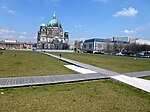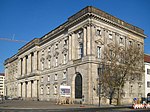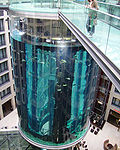Humboldt Forum

The Humboldt Forum is a museum of non-European art on the Museum Island in the historic centre of Berlin. Named in honour of the Prussian scholars Wilhelm and Alexander von Humboldt, it combines three rebuilt baroque façades of the former Royal Palace, a contemporary exterior overlooking the Spree river and a modern interior designed by Franco Stella. Considered as the "German equivalent" of the British Museum, the Humboldt Forum will mainly house the non-European collections of the Berlin State Museums, temporary exhibitions and public events. Due to the COVID-19 pandemic, it opened digitally on 16 December 2020 and became accessible for the general public on 20 July 2021. The Berlin Palace complex, which houses the Humboldt Forum, has been criticized as an attempt to downplay Germany's history of Prussian militarism. New York Times architectural critic Michael Kimmelman called it a "fake Baroque palace...a stage-set of an old capital, with phony, manufactured charm, erasing traces of the bad years of the 20th century."
Excerpt from the Wikipedia article Humboldt Forum (License: CC BY-SA 3.0, Authors, Images).Humboldt Forum
Schloßplatz, Berlin Mitte
Geographical coordinates (GPS) Address Nearby Places Show on map
Geographical coordinates (GPS)
| Latitude | Longitude |
|---|---|
| N 52.5175 ° | E 13.402777777778 ° |
Address
Berliner Schloss (Humboldt Forum)
Schloßplatz
10178 Berlin, Mitte
Germany
Open on Google Maps











